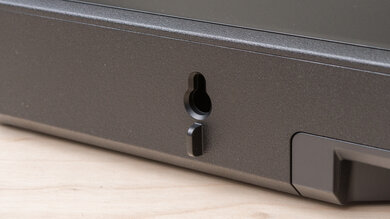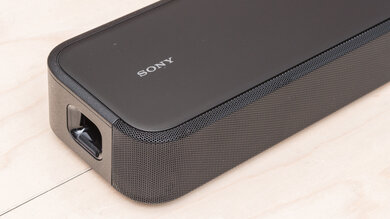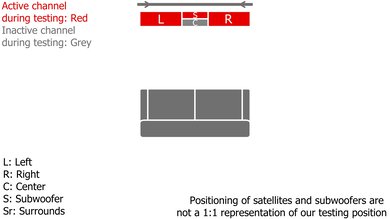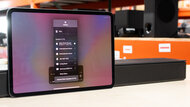The Sony HT-S2000 is a simple 3.1 soundbar released in 2023. It includes a discrete center channel to improve vocal reproduction, as well as a subwoofer integrated into the bar itself. With a smaller and more compact design, it doesn't take up a lot of space in your living room, either. Plus, you can connect it to other Sony subwoofers and satellites for improved performance. This soundbar 'supports' many different audio formats, from 5.1 surround sound like Dolby Digital to lossless and object-based formats like Dolby Atmos. However, it has to downmix them to stereo to play them.
Our Verdict
The Sony HT-S2000 is decent for mixed usage. This simple 3.1 soundbar is a solid upgrade over your existing TV speakers, with support for many different audio formats you'll likely come across on different streaming platforms. Its discrete center channel improves vocal clarity in the mix, too. However, since it has to downmix height and surround sound formats into stereo to play them back, it can't provide a more immersive feel to your audio. It lacks low-bass, too, so you don't feel as much thump and rumble in action-packed movie scenes.
-
Subwoofer level adjustment.
-
Supports many different audio formats.
-
Lacks low-bass.
-
Downmixes height and surround sound to stereo.
The Sony HT-S2000 is good for dialogue-centric content like TV shows. This 3.1 soundbar comes with a discrete center channel designed to improve vocal clarity in the mix. With an even and balanced sound, voices are reproduced with detail, so it's easy to follow along with the conversations on screen. There's even a dialogue enhancement tool on hand, which is a nice touch. However, you're pretty limited in sound customization outside of that since the bar lacks bass and treble adjustments or a graphic EQ.
-
Gets loud.
-
Dialogue enhancement tool.
-
No bass and treble adjustments.
The Sony S2000 is alright for music. Out-of-the-box, it offers a fairly even and balanced sound suitable for listening to most music genres. Voices and lead instruments are reproduced with clarity, too. However, like most bars with an integrated subwoofer, it lacks the deep thump and rumble that brings genres like EDM and hip-hop to life. There's no room correction tool, so it sounds a little different based on the acoustics of your space, and you're limited to a subwoofer level adjustment tool for manual customization.
-
Subwoofer level adjustment.
-
Gets loud.
-
No bass and treble adjustments.
-
Lacks low-bass.
The Sony S2000 is passable for movies. This simple 3.1 soundbar supports many of the audio formats commonly found on streaming platforms and Blu-rays, from Dolby Digital to Dolby Atmos. However, given its setup, it has to downmix this content into stereo sound to play it back. The resulting sound isn't as clear or as real as what you get with more premium setups, and sound effects don't stretch to the space around you for an immersive feel. The lack of low-bass is noticeable in some action-packed scenes, too.
-
Gets loud.
-
Supports many different audio formats.
-
Lacks low-bass.
-
Downmixes height and surround sound to stereo.
- 7.0 Mixed Usage
- 7.5 Dialogue/TV Shows
- 6.7 Music
- 6.8 Movies
Changelog
- Updated Sep 20, 2024: Updated the Stereo Dynamics, Stereo Frequency Response With Preliminary Calibrations, and Surround 5.1 results with new methodology from Test Bench 1.3 and accompanying text. Added text to Audio Latency: ARC, Audio Latency: HDMI In, and Audio Latency: Optical boxes.
- Updated Sep 19, 2024: We've converted this review to Test Bench Update 1.3. If applicable, we've retested stereo sound based on the manufacturer's recommendations. Additionally, we've expanded our audio latency tests to the following boxes: Audio Latency: ARC, Audio Latency: HDMI In, and Audio Latency: Optical. You can see the full changelog here.
- Updated Jun 28, 2023: Review published.
- Updated Jun 22, 2023: Early access published.
- Updated Jun 19, 2023: Our testers have started testing this product.
Check Price
Differences Between Sizes And Variants
The Sony HT-S2000 is available in Black. You can see the label for the model we tested here.
If you come across another version of this soundbar, let us know in the forums so we can update our review.
Compared To Other Soundbars
The Sony HT-S2000 is a 3.1 setup released in 2023. As with other models, like the Sony HT-A5000 and the Sony HT-A3000, it has a virtual surround tool called Sound Field that's designed to provide a more immersive sound, even if it doesn't noticeably improve the sound in practice. It's designed to be a simple upgrade over your existing TV speakers, and while it doesn't provide as premium of an audio experience as more high-end models, its ability to reproduce lots of different audio formats helps it stand out from the crowd.
You can also check out our recommendations for the best soundbars, the best small soundbars, and the best Dolby Atmos soundbars.
The Sony HT-A3000 and the Sony HT-S2000 are both standalone 3.1 setups with similar overall performances. The HT-A3000 has a few extra features, as it supports more wireless playback options, and you can connect it to a compatible BRAVIA TV for its Acoustic Center Sync feature.
The Sony HT-G700 is a better 3.1 soundbar than the Sony HT-S2000. The HT-G700 has a dedicated subwoofer, offering better bass reproduction. Plus, it has an HDMI input for video passthrough, unlike the HT-S2000. Its stereo soundstage and stereo dynamics performances aren't as good as the HT-S2000. The HT-S2000 is a good alternative if you don't have room for a subwoofer in your living room.
The Sony HT-Z9F and the Sony HT-S2000 are both 3.1 soundbars with support for many different audio formats. The HT-Z9F is the better of the two, though, largely because it comes with a dedicated subwoofer for improved bass reproduction. It supports more wireless playback options, too, and since it comes with an HDMI input, you can use it for video passthrough, unlike the HT-S2000.
The Samsung HW-Q60B is a better 3.1 setup than the Sony HT-S2000. Since it comes with a dedicated subwoofer, it offers better bass reproduction. It comes with more features, too, such as a graphic EQ for sound customization and an HDMI input for video passthrough.
Test Results
There's a subwoofer integrated into the bar itself. You can add on a compatible sub from the manufacturer separately as well.
The manufacturer sells compatible satellites separately.
The Sony HT-S2000 has a great build quality. Overall, it feels very solid. The metal grille in the front of the bar helps protect the drivers inside, too. The rest of the bar is made of plastic, which feels quite sturdy, though the top panel, in particular, is prone to picking up fingerprints when you handle it.
The Sony HT-S2000 has a decent stereo frequency response. Overall, the sound profile is quite even, especially in the mids, where more voices and lead instruments are reproduced. It performs well for a bar of its size, but of course, without a dedicated subwoofer, it lacks a lot of thump and rumble in the low-bass. You can always add a separate subwoofer from the manufacturer if you want a better performance.
We tested the bar with Sound Field Off, which resulted in a more natural sound. Sound Field is a virtual surround tool that's designed to provide a more immersive feel to your audio, and depending on your preferences, you may find it more to your liking. However, in our view, stereo audio seems unnatural with this feature activated, and voices echo in the mix. This may be because, with Sound Field on, stereo content plays from the center channel in addition to the right and left channels.
This soundbar comes with three different subwoofer levels: MIN, MID, and MAX. It's set to MID by default, but the MAX setting is ideal if you prefer a more neutral sound with stereo content. It adds a little more warmth in the bass range, which is nice. Some content, especially bass-heavy music like EDM, seems a bit boomier in this setting, which may not be ideal for everyone.
The Sony HT-S2000 has a decent stereo soundstage. The soundstage is perceived to be a little bit wider than the bar itself, and the bar isn't very wide, to begin with. Turning on the Sound Field feature results in a narrower sound with some content, including Money by Pink Floyd. On the upside, focus is good, so it's easy to pinpoint certain instruments and voices to more exact locations within the soundstage.
This soundbar has very good stereo dynamics. It doesn't have much compression at max volume, meaning you can enjoy a clean and clear sound even when you crank up the volume.
This 3.1 setup comes with a discrete center channel designed to improve vocal reproduction in the mix. Though the channel's frequency response is missing some low-bass, this isn't a huge deal since most voices are reproduced in the mid-range. As a result, dialogue remains clear and easy to follow.
The Sony HT-S2000 lacks discrete surround speakers, so it has to downmix 5.1 content like Dolby Digital into stereo to play it back. The resulting sound is less clear and real overall—audio seems like it's coming from a speaker placed in front of you, and sound effects don't stretch into the space around you. You can improve the bar's performance by adding separate satellites from the manufacturer, though.
This 3.1 setup can playback Dolby Atmos content, which is increasingly common on both streaming platforms and Blu-rays. Since it lacks up-firing channels, it has to downmix this content into stereo to play it. The resulting sound isn't as immersive as what you get with more premium bars, but thanks to its even frequency response, sound effects are reproduced with clarity and detail.
Our subjective evaluations of the bar's Atmos performance confirm that it's a good upgrade over your existing TV speakers with this content. Of course, since it downmixes this content into stereo, the sound is centered to the front of the room, and you don't get the feeling of effects stretching around the room or above your head. It's also missing some rumble in the low-bass, especially noticeable during more action-packed scenes. Again, listening with Sound Field Off provides a more natural sound, while turning this feature on seems to narrow the soundstage in some instances, so you don't get the same clear and real feel.
As with most Sony soundbars, the Sony HT-S2000 doesn't offer a ton of sound enhancement features. You won't find a room correction feature, so it sounds slightly different depending on your room. You're limited in terms of manual customization, too, with only a subwoofer level adjustment tool on hand instead of more traditional bass and treble adjustments. As for EQ presets, you can choose between turning the virtual surround feature called Sound Field on and off, but that's it. You can also use the app to access other features like the dynamic range compressor (DRC), which reduces the volume imbalance between different programs and commercials.
You can connect the bar to your TV using an HDMI or Optical connection. It lacks a Full HDMI in port, though, so you can't use the bar as a hub between devices for video passthrough.
The Sony HT-S2000 supports most common audio formats found on both streaming platforms and Blu-rays with Sound Field Off, which is how we tested the bar. However, Dolby Digital content isn't correctly implemented with Sound Field On. Effects meant for either the left or right channels play simultaneously on both the left and right channels, which may explain why the soundstage seems narrow with this virtual surround feature turned on.
Whether you listen with Sound Field turned on or off, this bar supports both Dolby Digital and DTS content via Optical. Dolby Digital is the more common of the two, while DTS is often used as a fallback for higher-quality DTS-HD MA often found on Blu-rays.
The soundbar's ARC latency is okay. Across all audio formats, its latency is about the same, and it's elevated enough that without compensation, you'll notice a bit of lipsync mismatch. Some TV settings and apps can compensate for latency, though.
The Sony HT-S2000 has an okay Optical latency performance. The Dolby Digital audio format over Optical has a higher latency than PCM, but certain apps and TVs compensate for latency differently, too. If you have any issues, you can always use the app's A/V Sync feature to manually adjust the delay.
Without an HDMI input, you can't use the bar for video passthrough to your TV.
You can wirelessly stream audio from your mobile devices to the bar via Bluetooth.
The remote is pretty simple compared to other Sony soundbar remotes, making it easy to find the needed features. If you prefer to control the bar from your phone, you can also download the Home Entertainment Connect app.
Comments
Sony HT-S2000: Main Discussion
Let us know why you want us to review the product here, or encourage others to vote for this product.
Update: Updated the Stereo Dynamics, Stereo Frequency Response With Preliminary Calibrations, and Surround 5.1 results with new methodology from Test Bench 1.3 and accompanying text. Added text to Audio Latency: ARC, Audio Latency: HDMI In, and Audio Latency: Optical boxes.




































